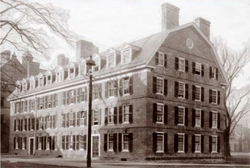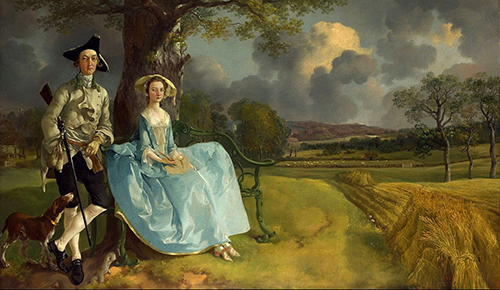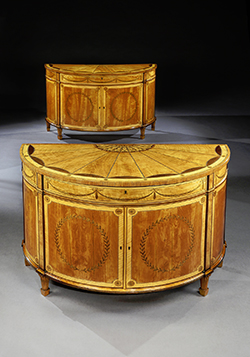MENU
The Electronic Scholarly Publishing Project: Providing access to classic scientific papers and other scholarly materials, since 1993. More About: ESP | OUR CONTENT | THIS WEBSITE | WHAT'S NEW | WHAT'S HOT
Comparative Timelines
The ESP Timeline (one of the site's most popular features) has been completely updated to allow the user to select (using the timeline controls above each column) different topics for the left and right sides of the display.
Select:
New Left Column
New Left Column
Dates
Decade
New Right Column
New Right Column
 Construction is started on Connecticut Hall at Yale, now the oldest building in New Haven and a National Historic Landmark.
Construction is started on Connecticut Hall at Yale, now the oldest building in New Haven and a National Historic Landmark.
 Painting by Thomas Gainsborough: Mr and Mrs Andrews is one of his most famous works. However, it remained in the family of the sitters until 1960 and was very little known before it appeared in an exhibition in Ipswich in 1927. The work is an unusual combination of two common types of painting of the period: a double portrait, here of a recently married couple, and a landscape view of the English countryside. Gainsborough's work mainly consisted of these two different genres, but their striking combination side-by-side in this extended horizontal format is unique in Gainsborough's oeuvre, and extremely rare in other painters.
Painting by Thomas Gainsborough: Mr and Mrs Andrews is one of his most famous works. However, it remained in the family of the sitters until 1960 and was very little known before it appeared in an exhibition in Ipswich in 1927. The work is an unusual combination of two common types of painting of the period: a double portrait, here of a recently married couple, and a landscape view of the English countryside. Gainsborough's work mainly consisted of these two different genres, but their striking combination side-by-side in this extended horizontal format is unique in Gainsborough's oeuvre, and extremely rare in other painters.
 Carolus Linnaeus's Philosophia Botanica rejects any notion of evolution and continues his work in classifying plants.
Carolus Linnaeus's Philosophia Botanica rejects any notion of evolution and continues his work in classifying plants.
John Needham publishes Nouvelles Observations Microscopiques arguing that decomposing plant and animal matter can spontaneously generate new life. Fifteen years later, Italian polymath Lazzaro Spallanzani will conduct a more careful set of experiments then publish a report rejecting Needham's conclusions.
1750
(no entry for this year)
The minuet becomes a fashionable dance in Europe.
Colonial South Carolina prohibits slaves from learning about or practicing medicine.
George II repeals the 1705 act, making slaves real estate in Virginia.
 Linnaeus's Species Plantarum completes his development of the use of binary nomenclature in botany. The work still provides the foundation for the modern classification of species.
Linnaeus's Species Plantarum completes his development of the use of binary nomenclature in botany. The work still provides the foundation for the modern classification of species.
 Pierre-Louis de Maupertuis's Système de la Nature provides a theoretical speculation on heredity and the origin of species by chance.
Pierre-Louis de Maupertuis's Système de la Nature provides a theoretical speculation on heredity and the origin of species by chance.
 Étienne Bonnot de Condillac's Traité de sensations claims that knowledge reaches humans only through the senses.
Étienne Bonnot de Condillac's Traité de sensations claims that knowledge reaches humans only through the senses.
 Benjamin Franklin describes electricity as a single fluid and distinguishes between positive and negative electricity in Experiments and Observations on Electricity. He shows that electricity can magnetize and demagnetize iron needles.
Benjamin Franklin describes electricity as a single fluid and distinguishes between positive and negative electricity in Experiments and Observations on Electricity. He shows that electricity can magnetize and demagnetize iron needles.
Encyclopedists Diderot and d'Alembert publish the first volume of the Encyclopedia, or Classified Dictionary of Sciences, Arts and Trades emphasizing a dispassionate presentation of factual information rather than reliance on age-old "wisdom."
1751
(no entry for this year)
 The lightning conductor is invented by Benjamin Franklin, whose experiments with lightning include a flying a kite in a thunderstorm. The kite experiment shows that lightning is a form of electricity, similar to the discharge from a Leyden jar.
The lightning conductor is invented by Benjamin Franklin, whose experiments with lightning include a flying a kite in a thunderstorm. The kite experiment shows that lightning is a form of electricity, similar to the discharge from a Leyden jar.
Stung by satires of its Philosophical Transactions, the Royal Society of London forms a committee that will vote on which papers merit publication.
1752
(no entry for this year)
 Thomas Chippendale begins making furniture in his workshop in London, England.
Thomas Chippendale begins making furniture in his workshop in London, England.
 English painter and engraver William Hogarth publishes the aesthetic treatise, The Analysis of Beauty.
English painter and engraver William Hogarth publishes the aesthetic treatise, The Analysis of Beauty.
Tobacco genus named by a Swedish botanist Carolus Linnaeus — Nicotiana rustica and Nicotiana tabacum named for the first time.
 Russian scientist Georg Wilhelm Richmann is killed performing a lightning experiment in St. Petersburg. Richmann is electrocuted in while trying to quantify the response of an insulated rod to a nearby storm. The incident, reported worldwide, underscored the dangers inherent in experimenting with insulated rods and in using protective rods with faulty ground connections.
Russian scientist Georg Wilhelm Richmann is killed performing a lightning experiment in St. Petersburg. Richmann is electrocuted in while trying to quantify the response of an insulated rod to a nearby storm. The incident, reported worldwide, underscored the dangers inherent in experimenting with insulated rods and in using protective rods with faulty ground connections.
The British Museum opens.
1753
(no entry for this year)
The French and Indian War breaks out on the North American continent between the European powers Britain and France.
1754
(no entry for this year)
 English critic and writer Samuel Johnson publishes A Dictionary of the English Language, a landmark of lexicography that he has compiled by himself over the course of eight years.
English critic and writer Samuel Johnson publishes A Dictionary of the English Language, a landmark of lexicography that he has compiled by himself over the course of eight years.
 The Great Lisbon Earthquake occurs, killing more than 60,000 people. The huge earthquake (estimated at 9.0 on the modern Richter scale) strikes Lisbon, Portugal, at 9:40 am, on 1 November, during church services for All Saint's Day. Because the earthquake hits on an important church holiday and destroys almost every important church in the city, much anxiety and confusion is generated amongst the citizens of this staunch and devout Roman Catholic city and country, which had been a major patron of the Church. Theologians speculate on the religious cause and message, seeing the earthquake as a manifestation of the anger of God. Some philosophers struggle to reconcile the event with the concept that humanity lives in the best of all possible worlds — a world closely supervised by a benevolent deity.
The Great Lisbon Earthquake occurs, killing more than 60,000 people. The huge earthquake (estimated at 9.0 on the modern Richter scale) strikes Lisbon, Portugal, at 9:40 am, on 1 November, during church services for All Saint's Day. Because the earthquake hits on an important church holiday and destroys almost every important church in the city, much anxiety and confusion is generated amongst the citizens of this staunch and devout Roman Catholic city and country, which had been a major patron of the Church. Theologians speculate on the religious cause and message, seeing the earthquake as a manifestation of the anger of God. Some philosophers struggle to reconcile the event with the concept that humanity lives in the best of all possible worlds — a world closely supervised by a benevolent deity.
1755
(no entry for this year)
 English statesman and writer Edmund Burke publishes A Philosophical Inquiry into the Origin of Our Ideas of the Sublime and Beautiful. This work of aesthetics, with its emphasis on the sublime, will have a powerful influence on romantic artists and writers.
English statesman and writer Edmund Burke publishes A Philosophical Inquiry into the Origin of Our Ideas of the Sublime and Beautiful. This work of aesthetics, with its emphasis on the sublime, will have a powerful influence on romantic artists and writers.
 William Cullen observes the cooling effect of evaporating liquids and publishes the results in An Essay on the Cold Produced by Evaporating Fluids and Other Means of Producing Cold.
William Cullen observes the cooling effect of evaporating liquids and publishes the results in An Essay on the Cold Produced by Evaporating Fluids and Other Means of Producing Cold.
1756
(no entry for this year)
(no entry for this year)
1757
(no entry for this year)
The first English manual on guitar playing is published.
Pennsylvania Quakers forbid their members from owning slaves or participating in the slave trade.
Henri-Louis Duhamel du Monceau discovers that when he turns a seedling upside down, its roots and shoots reorient so that the root continues to grow downward while the shoot continues to grow upward.
1758
(no entry for this year)
 Voltaire publishes his great satirical work Candide, inspired in part by the Great Lisbon Earthquake.
Voltaire publishes his great satirical work Candide, inspired in part by the Great Lisbon Earthquake.
The British capture Québec from the French.
 In Theoria Generationis (his MD dissertation), Caspar Friedrich Wolff claims the existence of a vis essentialis — an essential force — that is at the heart of all living matter. He also describes the differentiation of tissues in a developing embryo, refuting the preformation concept — the idea that development consists in the growth of a fully formed, but miniature individual. His views were not well received.
In Theoria Generationis (his MD dissertation), Caspar Friedrich Wolff claims the existence of a vis essentialis — an essential force — that is at the heart of all living matter. He also describes the differentiation of tissues in a developing embryo, refuting the preformation concept — the idea that development consists in the growth of a fully formed, but miniature individual. His views were not well received.
The Kew Botanical Gardens open in London.
1759
(no entry for this year)
ESP Quick Facts
ESP Origins
In the early 1990's, Robert Robbins was a faculty member at Johns Hopkins, where he directed the informatics core of GDB — the human gene-mapping database of the international human genome project. To share papers with colleagues around the world, he set up a small paper-sharing section on his personal web page. This small project evolved into The Electronic Scholarly Publishing Project.
ESP Support
In 1995, Robbins became the VP/IT of the Fred Hutchinson Cancer Research Center in Seattle, WA. Soon after arriving in Seattle, Robbins secured funding, through the ELSI component of the US Human Genome Project, to create the original ESP.ORG web site, with the formal goal of providing free, world-wide access to the literature of classical genetics.
ESP Rationale
Although the methods of molecular biology can seem almost magical to the uninitiated, the original techniques of classical genetics are readily appreciated by one and all: cross individuals that differ in some inherited trait, collect all of the progeny, score their attributes, and propose mechanisms to explain the patterns of inheritance observed.
ESP Goal
In reading the early works of classical genetics, one is drawn, almost inexorably, into ever more complex models, until molecular explanations begin to seem both necessary and natural. At that point, the tools for understanding genome research are at hand. Assisting readers reach this point was the original goal of The Electronic Scholarly Publishing Project.
ESP Usage
Usage of the site grew rapidly and has remained high. Faculty began to use the site for their assigned readings. Other on-line publishers, ranging from The New York Times to Nature referenced ESP materials in their own publications. Nobel laureates (e.g., Joshua Lederberg) regularly used the site and even wrote to suggest changes and improvements.
ESP Content
When the site began, no journals were making their early content available in digital format. As a result, ESP was obliged to digitize classic literature before it could be made available. For many important papers — such as Mendel's original paper or the first genetic map — ESP had to produce entirely new typeset versions of the works, if they were to be available in a high-quality format.
ESP Help
Early support from the DOE component of the Human Genome Project was critically important for getting the ESP project on a firm foundation. Since that funding ended (nearly 20 years ago), the project has been operated as a purely volunteer effort. Anyone wishing to assist in these efforts should send an email to Robbins.
ESP Plans
With the development of methods for adding typeset side notes to PDF files, the ESP project now plans to add annotated versions of some classical papers to its holdings. We also plan to add new reference and pedagogical material. We have already started providing regularly updated, comprehensive bibliographies to the ESP.ORG site.
ESP Picks from Around the Web (updated 06 MAR 2017 )
Old Science

Weird Science

Treating Disease with Fecal Transplantation
Fossils of miniature humans (hobbits) discovered in Indonesia

Dinosaur tail, complete with feathers, found preserved in amber.
Astronomy

Mysterious fast radio burst (FRB) detected in the distant universe.